Women in aviation
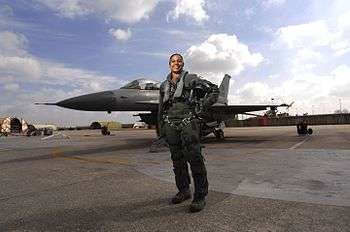
Women have been involved in aviation from the beginnings of both lighter-than air travel and as airplanes, helicopters and space travel were developed. Women pilots were also called "aviatrices" (singular: "aviatrix"). Women have been flying powered aircraft since 1908, however most, prior to 1970, were restricted to working privately or in support roles in the aviation industry.[1] Aviation also allowed women to "travel alone on unprecedented journeys."[2] Women who have been successful in various aviation fields have served as mentors to younger women, helping them along in their careers.[3]
Within the first two decades of powered flight, women on every continent except Antarctica had begun to fly, perform in aerial shows, parachute, and even transport passengers. They were increasingly involved in establishing distance records, aerobatic records and pressing for airplanes to be used for disaster and public health services. During World War II, women from every continent helped with war efforts and though mostly restricted from military flight many of the female pilots flew in auxiliary services. In the 1950s and 1960s, women were primarily restricted to serving in support fields like flight simulation training, air traffic control, and as flight attendants. Since the 1970s, women have been allowed to participate in military service in most countries.
Women's participation in the field of aviation has increased over the years. In the United States, in 1930, there were around 200 women pilots but in five years there were more than 700.[4] Women of Aviation Worldwide Week has reported that after 1980, the increase in gender parity for women pilots in the United States has been stagnant.[5] Women flying commercial airlines in India make up 11.6% of all pilots, significantly further ahead than the global number of women airline pilots which is 3%.[6]
History
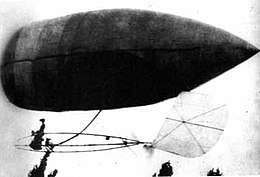
The first woman known to fly was Élisabeth Thible, who was a passenger in an untethered hot air balloon, which flew above Lyon, France in 1784.[7] Four years later, Jeanne Labrosse became the first woman to fly solo in a balloon and would become the first woman to parachute, as well.[8][9] Sophie Blanchard took her first balloon flight in 1804, was performing as a professional aeronaut by 1810 and was made Napoleon's chief of air service in 1811.[10] Blanchard, the first woman who was a professional in the air, died in a spectacular crash in 1819.[11] In June 1903, Aida de Acosta, an American woman vacationing in Paris, convinced Alberto Santos-Dumont, pioneer of dirigibles to allow her to pilot his airship, becoming probably the first woman to pilot a motorized aircraft.[12]
The first machine-powered flight was accomplished by the Wright Brothers on December 17, 1903. Both brothers felt that it was important to recognize the contributions of Katherine Wright to their work.[13] She found teachers who could help with the Wright's flying experiments.[14] Katherine, while she didn't fly with her brothers until later in 1909,[13] knew "everything about the working of their machines."[15] Katherine supported them financially, giving them her savings and also supported them emotionally.[16] When Orville Wright was injured in 1908, Katherine moved close to the hospital to take care of him.[17] Later, after the Wright brothers patented their aircraft in 1906, she worked as their executive secretary.[14] In 1909, she traveled to Europe to become the social manager for her brothers.[14] Her brothers were very introverted and relied on Katherine to help promote their work.[18] Katherine was considered the "silent partner" of the Wright Brothers by The World Magazine.[15] The Saint Louis Post-Dispatch called her the "inspiration of her brothers in their experiments."[19]
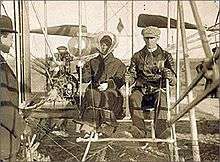
Starting 1906, another inventor of aircraft, Emma Lilian Todd began designing her own airplanes.[20] Todd first started studying dirigibles before she moved onto designing airplanes.[21] Todd's first plane flew in 1910 and was piloted by Didier Masson.[20] A woman who was an early parachutist, Georgia "Tiny" Broadwick started working with barnstormer, Charles Broadwick at age 15 in 1908.[22][23] She made her first jump in 1908, and in 1913, became the first woman to jump from an aircraft.[23][22] Broadwick, in 1914, was also the person who gave the first demonstrations of parachute jumping to the United States government.[23] When she retired in 1922, she had completed 1,100 jumps.[22]
The first woman passenger in an airplane was Mlle P. Van Pottelsberghe de la Poterie who flew with Henri Farman on several short flights at an airshow in Ghent, Belgium between May and June 1908. Soon after, in July, 1908, sculptor Thérèse Peltier was taken up as a passenger by Léon Delagrange[24] and within a few months had been reported as making a solo flight in Turin, Italy, flying around 200 meters in a straight line about two and a half meters off the ground. Edith Berg, an American, who flew as a passenger with Wilbur Wright in Paris in October 1908, was the inspiration of the hobble skirt designed by Paul Poiret. [25][26]
1910s
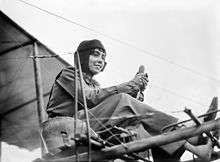
Early pioneers include French Raymonde de Laroche, the world's first licensed female pilot on March 8, 1910.[13][9] Seven other French women followed her, earning pilot's licenses within the next year.[27] One of these, Marie Marvingt, 3rd Frenchwoman licensed for airplanes,[28] but first French woman balloonist licensed in 1901,[29] became the first woman to fly in combat completing bombing raids over Germany.[30][31] Marvingt tried to get the government to outfit air ambulances prior to the war and became the world first certified Flight Nurse.[31] Hélène Dutrieu became the first woman pilot in Belgium, obtaining the 27th license issued in her country in 1910 and the second female licensed in Europe.[32][33] Later that same year, she became the first woman to fly with a passenger.[9] In 1910, even before she earned her pilot's license, Lilian Bland a British woman living in Northern Ireland, designed and flew a glider in Belfast.[34]
Blanche Scott always claimed to be the first American woman to fly an airplane, but as she was seated when a gust of wind took her up on her brief flight in September 1910, the "accidental" flight went unrecognized.[35] Within two years, she had established herself as a daredevil pilot and was known as the "Tomboy of the Air",[36] competing in air shows and exhibitions, as well as flying circuses.[37][36] On October 13, 1910, Bessica Raiche received a gold medal from the Aeronautical Society of New York, recognizing her as the first American woman to make a solo flight.[38] Harriet Quimby became the USA's first licensed female pilot on August 1, 1911 and the first woman to cross the English Channel by airplane the following year.[39] Thirteen days after Quimby,[40] her friend Matilde E. Moisant an American of French Canadian descent[41] was licensed and began flying in air shows. She broke a world altitude record in 1911.[42]
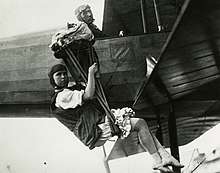
Within a fortnight, Lidia Zvereva had obtained the first female Russian license[43] and by 1914 she performed the first aerobatic loop made by a woman.[44] Hilda Hewlett became the first British woman to earn a pilot's license on August 29, 1911 and taught her son to fly that same year.[9] In September 1910, Melli Beese became Germany's first woman pilot and[45] the following year began designing her first airplane which was produced in 1913.[46] On October 10, 1911, Božena Laglerová a Czech native of Prague, obtained the first Austrian license for a woman and nine days later secured the second German license for a woman.[47] On 7 December 1910 Jane Herveu, who had previously been involved in automobile racing was licensed in France and began participating in the Femina Cup.[48]
Rosina Ferrario, first female pilot of Italy, earned her license on January 3, 1913 and was as unsuccessful as Marvingt had been to get her government or the Red Cross to allow women to transport wounded soldiers during World War I.[49] Elena Caragiani-Stoenescu, Romania's first woman pilot got the same response from her government about flying for the war effort and turned to journalism.[50] On December 1, 1913, Lyubov Golanchikova signed a contract to become the first female test pilot. She agreed to test "Farman-22" aircraft manufactured in the Chervonskaya airplane workshop of Fedor Fedorovich Tereshchenko[51] The first woman on the African Continent to earn a pilot's license was Ann Maria Bocciarelli of Kimberley, South Africa.[52]
In 1916, Zhang Xiahun (Chinese: 張俠魂) became China's first female pilot when she attended an airshow of the Nanyuan Aviation School and insisted that she be allowed to fly. After circling the field, tossing flowers, she crashed, becoming a national heroine when she survived.[53][54] Katherine Stinson became the first woman air mail pilot, when the United States Postal Service contracted her to fly mail from Chicago to New York City in 1918.[55] The following year, Ruth Law flew the first official U.S. air mail to the Philippines.[56]
Women were also involved in teaching others how to fly. Hilda Hewlett and Gustave Blondeau teamed up in 1910 to start the first flying school in England, The Hewlett-Blondeau School.[57] The school had only one plane with which to instruct students and was open for two years.[58] Charlotte Möhring, the second German woman to earn a pilot's license, worked as a manager of a flying school in 1913.[59]
1920s
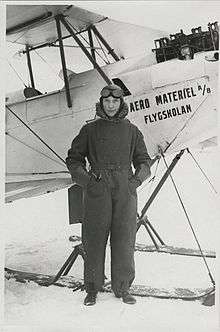
Both men and women after World War I were able to purchase "surplus and decommissioned planes."[60] Wanting to fly, but with little demand after the war, pilots purchased the planes and went from town to town offering rides. Creating attractions to bring in crowds, these daredevils performed stunts, loops and began wing walking to attract more customers. The aerialists and pilots formed flying circuses sending promoters ahead of them to hang posters promoting their dangerous feats.[61]
In 1920, Phoebe Fairgrave, later Omlie, at the age of eighteen determined to make her aviation career as a stuntwoman.[62][63] By 1921, she had broken the world parachute drop record[62] and worked as a wing walker for the Fox Moving Picture Company's The Perils of Pauline series. By 1927, Omlie earned the first transport pilots license and airplane mechanics license issued to a woman.[64] Another stuntwoman, Ethel Dare had perfected walking from one plane to another by 1920,[65] the first woman to perform the feat.[61]
Bessie Coleman was the first African American woman to become a licensed airplane pilot in 1921.[66] The following year, Japan's first woman pilot Tadashi Hyōdō earned her license.[67] Kwon Ki-ok of Korea became the first female licensee of that country in 1925 and after World War II, became instrumental in helping establish the Republic of Korea Air Force.[68][69] German Marga von Etzdorf was the first woman to fly for an airline when she began co-piloting for Lufthansa in 1927[70] and piloting solo on commercial Junkers F13 on 1 February 1928.[71]

In the late 1920s, women continued to compete in air races and record-breaking contests related to flying.[72] In 1929, Pancho Barnes moved to Hollywood to work as the first woman stunt pilot. Besides working on such films as Howard Hughes' Hell's Angels (1930),[73] she also founded the Associated Motion Pictures Pilots Union in 1931.[74] The first Women's Air Derby or Powder Puff Derby, an official women-only race from Santa Monica, California to Cleveland, Ohio, was held as part of the 1929 National Air Races and was won by Louise Thaden.[75]
Marie Marvingt of France, who had first proposed the idea of using airplanes as ambulances in 1912 continued to promote her idea successfully in the 1920s.[76] During the French colonial wars, Marvingt evacuated injured military personnel with Aviation Sanitaire, a flying ambulance service.[77] Canadian Elsie MacGill became the first woman to earn a master's degree in aeronautical engineering in 1929.[78] On November 2, 1929, at Curtiss Field in Valley Stream, New York, 26 women pilots gathered and formed an international organization to provide mutual support for advancing women pilots and named themselves The Ninety-Nines, after the number or charter members.[79]
1930s
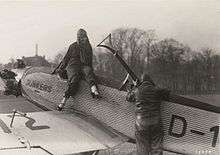
The 1929 stock market crash and ensuing depression, coupled with more stringent safety regulations, caused many of the flying circuses and barnstorming circuits to fold.[61] During the decade, options for women pilots in the United States were limited mainly to sales, marketing, racing and barnstorming and being an instructor pilot.[80] In 1930, Ellen Church, a pilot and nurse, who was unable to secure work flying proposed to airline executives that women be allowed to act as hostesses on planes. She was hired on a three-month trial basis by Boeing Air Transport and selected the first seven flight attendants for airlines, requiring them to be under 115 pounds, nurses and unmarried.[81][82]
Women continued to break records. In 1930, Amy Johnson an English aviator, made the first England to Australia flight by a woman.[83] Antonie Strassmann, a German emigre to the US, became the first woman to successfully cross the Atlantic aboard an aircraft, traveling in May 1932 with a team on a Dornier Do X flying boat .[84] In the fall of 1932, Strassmann piloted a Zeppelin from Germany to Pernambuco in Brazil. American Amelia Earhart, the first woman to fly solo across the Atlantic (1932).[13][85] Earhart became a public favorite among aviators of the time.[86] Earhart also urged the public to encourage and enable young women to become airplane pilots themselves.[87] In 1936 and 1937, she taught students at Purdue University which was "one of the few U.S. colleges to offer aviation classes to women".[88]
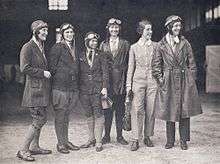
Hazel Ying Lee, a dual American-Chinese citizen, earned her pilot's license in 1932 in the United States. She went to China to volunteer to serve in the Chinese Army in after the Japanese invasion of Manchuria, but was rejected due to her sex. She flew commercial aircraft in Canton until returning to the United States in 1937. Joining the WASPS, in 1943, she delivered planes for the military until she was killed in service in 1944.[89] In 1933 Lotfia ElNadi became the first Egyptian woman and first Arab woman to earn a pilot's license.[90] That same year, Marina Raskova became the first Russian woman navigator for the Soviet Air Forces.[91] The following year she began teaching as the first female instructor at the Zhukovsky Air Force Academy[92] and then in 1935 received her certification as a flight instruments trainer.[93]
In 1934, Chinese actress Lee Ya-Ching obtained a pilot's license in Switzerland, the following year she obtained the first license for a woman from the American Boeing School of Aeronautics, and in 1936 became the first woman licensed by China as a pilot. She went on to found a civilian flying school in Shanghai that same year.[94][95] Sarla Thakral was first Indian woman to fly, earning her aviation pilot license in 1936 in a Gypsy Moth solo. She later completed over 1000 hours of flight time.[96][97] In 1935, Nancy Bird Walton obtained the first Australian license allowing a woman to carry passengers so that she could fly an ambulance service for the Royal Far West Children's Health Scheme. She later founded the Australian Women Pilots' Association.[98] That same year, Phyllis Doreen Hooper earned the first women pilot's license in South Africa. The following year, she became the first female licensed as a commercial pilot and within 2 years had become the first South African woman flight instructor.[99]
In 1936, Hanna Reitsch of Germany became the first person to fly a fully controllable helicopter[100][101] and within two years, she earned the first woman helicopter pilot's license.[102][103] In the prestigious Bendix Race in 1936, women not only took first place, but also second and fifth.[104] The following year, Sabiha Gökçen of Turkey became the first trained woman combat pilot, participating in search operations and bombing flights during the Dersim Rebellion. While Gökçen was not the first to have participated in military operations, she was the first woman to have been trained as a military pilot, graduating from the Aircraft School (Tayyare Mektebi) in Eskişehir.[105]
In 1939, the South African Women's Aviation Association (SAWAA) was formed with 110 women members. Colloquially known as the Women's Civil Air Guard, within the year, membership had swelled to between 3000 and 4000 members. With the outbreak of war, the organization changed focus to become the Women's Auxiliary of the South African Air Force.[106]
1940s
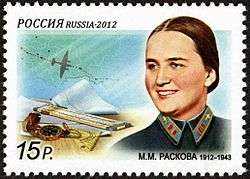
As World War II began, women became involved in combat. In the United States, prior to the war, pilots typically flew only in good weather, so that they could judge ground position. Flying in combat required pilots to fly in varying conditions, and a push for instrument training began. By 1944 around 6,000 women had been trained as Link Trainer operators and were teaching male pilots how to read instruments. WAVES like Patricia W. Malone transitioned after the war to commercial flight simulation instruction, where women dominated the industry of flight training operators.[107]
In 1939, Jacqueline Cochran wrote to the first lady, Eleanor Roosevelt, about using women pilots in the military.[108] Later, Nancy Harkness Love also made a similar request to the US Army, however both women's ideas were put on hold until 1942.[108] General Henry Arnold on September 14, 1942, put Cochran in charge of a new program called the Army Air Forces Women's Flying Training Detachment (WFTD).[108] By August 5, 1943, the WFTD was merged with the WAFS to form the Women Airforce Service Pilots (WASP).[108] The WASPs supported the military in various ways, flying new planes from factories to Army Air Force bases, worked as test pilots, worked as flying chauffeurs and helped tow targets for antiaircraft gunnery practice.[109] The WASPS never gained full military benefits, the organization was disbanded in December 1944. WASPS finally earned veteran status retroactively in 1979.[109]
Besides working as women pilots, American women also started working as air traffic controllers during WWII.[110] Commander Frances Biadosz was the only WAVE to wear wings for air-navigation during World War II.[111] Women in the United States were also hired by the National Advisory Committee for Aeronautics (NACA) to work as scientists and engineers, as well as analysts, reviewing data from windtunnels on airplane prototypes.[112]
In 1940, Major Phyllis Dunning (née Phyllis Doreen Hooper) became the first South African woman to enter full-time military service as the Commander of the South African Women's Auxiliary Air Force (SAWAAF).[113] In 1941, the Southern Rhodesia Women's Auxiliary Air Service was commissioned. Within a few months over 100 women recruits were providing clerical services, sewing skills, parachute packing, and serving as drivers, equipment assistants and mechanics.[114] Another South African, Rosamund Steenkamp became the first woman in the world to fly a jet, when she flew a Gloster Meteor III in August 1945, which was still in its experimental stages, for the British Air Transport's Auxiliary Service.[115]
The Air Transport Auxiliary (ATA), a British civilian operation during World War II, had scores of female pilots, under the command of Pauline Gower. Valérie André, a neurosurgeon and member of the French army, became the first woman to fly a helicopter in combat, while serving in Indochina (1945).[116] Margot Duhalde, a Chilean woman, flew transport missions for the ATA during World War II and after the war became the first woman pilot of the Free French Air Forces, flying transports to Morocco. For her services, Duhalde was made a Knight of the Legion of Honour in 1946.[117] The Royal Canadian Air Force created a Women's Division in 1942, offering women 2/3 the pay of their male counterparts. Though barred from combat and flying, women performed aircraft maintenance and served in air traffic control, in addition to other duties. By the end of the war, over 17,000 Canadian women had served in the Women's Division either at home or abroad.[118]
Korean Lee Jeong-hee, who had earned her pilot's license in 1927, joined the Republic of Korea Air Force in 1948 and was appointed first lieutenant. She was the founding commander of the Women's Air Force Corps in 1949, but was captured and taken to North Korea when the Korean War broke out.[119][120]
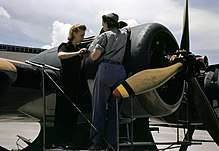
Unlike other countries fighting in WWII, the Soviet Union created an all-woman combat flight unit, the 599th Night Bomber Regiment or the Night Witches. This group of the Soviet Air Forces, flew harassment bombing and precision bombing missions from 1942 to the end of the World War II.[121] The organization was first formed by Joseph Stalin on October 8, 1941 and all of the women were volunteers.[122] The Night Witches flew 30,000 missions and "dumped 23,000 tons of bombs on the German invaders".[122] The Soviets also had the only women to be considered flying aces. Lydia Litvyak was credited with different numbers of kills from various sources, but in 1990, the tally was given as 12 solo kills and 3 shared kills.[123][124] Yekaterina Budanova fought combat missions over Saratov and Stalingrad and was credited with 11 kills.[123][125]
In 1948 Ada Rogato, Brazil's first licensed woman pilot, became the first female agricultural pilot when she was hired by the government to crop dust coffee fields and eliminate the borer beetle that was plaguing the crop.[126][127] The following year, Rogato became the first woman to fly solo over the Andes and in 1951, flew from Tierra del Fuego to Alaska, a solo flight which would take her across South America, Central America and North America.[126][128] In 1948, Isabella Ribeiro de Cabral, who became Isabella de Freitas the following year, became the first woman pilot of Trinidad and Tobago.[129] It would be another forty years, in 1988, before the first Trinidadian woman, Wendy Yawching became a captain.[130][131]
1950s
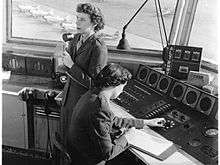
Women continued to break records and fly during the 1950s. In 1951, the People's Liberation Army Air Force (PLAAF) of China enrolled 55 women trainees. When they graduated, the following year, the women represented 6 communication operators, 5 navigators, 30 on-board aircraft mechanics and 14 pilots. A second class of 160 trainees entered PLAAF in 1956, but only 44 of them completed their training.[132]
In 1952, Earsley Barnett, American wife of Major Carl Barnett, founder of Wings Jamaica, earned the first pilot license granted to a woman in Jamaica. She later became the first Jamaican flight instructor, as well as a commercial pilot.[133] Jacqueline Cochran became the first woman to break the sound barrier in 1953. Cochran wanted to not only be the first woman to set a record, she wanted to be the first person to do so and by June 1953, she was the holder of "all but one of the principal world airplane speed records for straightaway and closed-course flight."[134]
During the Korean War, former WASPs were asked to join active duty in the Air Force.[135] Thirteen percent of the WAVES recruits by 1952 were air selected for air training, which included positions as air control personnel, aerographer's mates, electronics technicians and as other support personnel. In 1953, the WAVES lifted a ban on women serving as mechanics.[111] Kim Kyung-Oh was the only South Korean woman to serve as a pilot in the ROK Air Force during the Korean War.[136][137]
_and_Margaret_Sincotts_in_the_cockpit_of_an_Auster_J-4_Archer_monoplane_on_the_tarmac_at_an_airfield%2C_1953_(16289750475).jpg)
Organizations were formed, such as the Australia Women's Pilot's Association (AWPA).[138] Another organization was the Whirly-Girls, started by Jean Ross Howard Phelan in 1955 for women helicopter pilots. She started the group as an informal interest group, but formalized it in order to better help the members network and support each other in the male-dominated field.[139]
Pakistan modeled its air force on the British Royal Air Force during the late 1950s. This allowed for more women to become involved in the military in Pakistan.[140] In 1958 Dorothy Rungeling of Canada became her country's first woman to solo pilot a helicopter.[141]
In the 1950s and 1960s, air travel was expensive and few people of color could afford to fly. U.S. segregation laws were slowly being overturned to lift barriers for not only travel, but for employment opportunities.[142][143] Coupled with the influx of workers from the Indian subcontinent and the Caribbean, and the independence movements in Africa and the Caribbean, British need for labor in the post-war period made recruiting of 'coloured labour' in the same period a necessity.[144] The following decades would increasingly see more women from former colonies enter aviation.[145][146][147][148][149][150][151]
1960s

In the 1960s, stewardesses, as flight attendants were known, were considered glamorous and exotic adventurers. Frank Sinatra's song Come Fly with Me gave birth to the jet set.[152] Adding to the allure, Bernard Glemser's novel, Girl on a Wing, and the British movie based on it, Come Fly with Me (1963), depicted stewardesses as stylish seekers of romance.[153] Wearing custom-fitted uniforms, attendants were career women, whose looks, marital status and childlessness were guarded by industry executives, much as Hollywood starlets had been. On the one hand, they were to project an ideal of womanhood, but on the other, they were used to sell airline travel through their sexuality. The double-standard that they faced as well as the glamorous lifestyle they lived, shot to the best-seller's list with the publication in 1967 of the book, Coffee, Tea or Me?[152] In 1963, stewardesses who held a press conference on airlines' policy of retiring stewardesses at 32, caught the attention of the country. The press conference focused attention on the airlines narrow standard of "feminine allure".[154]
In 1960, Olga Tarling became the first woman air traffic controller in Australia[155] and Yvonne Pope Sintes and Frankie O'Kane become the first female British air traffic controllers.[156] That same year, Alia Menchari became the first woman Tunisian pilot.[146] In 1961, Lucille Golas attained the first pilot license for a woman in Guyana to assist her husband in his mining business.[157] Asegedech Assefa became the first Ethiopian woman to earn a pilot's license in 1962.[158] That same year, Jacqueline Cochran became the first woman to fly a jet across the Atlantic Ocean.[9]
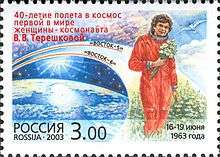
A privately funded project, of William Lovelace, the Woman in Space Program recruited women pilots in the U.S. to test them for suitability for the space program. Thirteen of the recruits passed NASA's physical requirements. Scheduled for additional testing, the United States Navy canceled use of their facilities as there were no NASA officials involved. Public hearings were held by a special Subcommittee of the House Committee on Science and Astronautics in 1962. Because NASA required all astronauts to attain an engineering degree and be graduates of military jet piloting test programs, none of the women could meet the entry prerequisites. The subcommittee took no action after the hearing. The following year, Valentina Tereshkova,[159] an amateur Russian parachute jumper became the first woman in space.[160]
In 1963, Betty Miller became the first woman to fly solo across the Pacific Ocean[161] and Anne Spoerry, a French doctor living in Kenya became the first female member of the African Medical and Research Foundation's "Flying Doctors", operating her plane through the bush to provide needed medical assistance in remote areas.[162] In 1964, women again made history when Geraldine Mock became the first woman to circumnavigate the globe.[9]
Because of the unpopularity of the Vietnam War in the United States, men were not volunteering at high enough rates; however, many women were being turned away because of limits on women's work in the military. In 1967, a law was passed allowing more women into the military and to be promoted to high ranks.[163] In 1969, Kucki von Gerlach obtained the first pilot's license issued to a woman in South West Africa, now Namibia.[145] That same year, Turi Widerøe of Norway became the first female pilot for Scandinavian Airlines.[164] Turi Widerøe had for years been a pilot for her fathers company Widerøe, which today is the largest regional airline in the Scandinavian countries. Turi Widerøe is still today recgognized as the western worlds first woman commercial pilot for a major airlines after she joined Scandinavian Airlines in 1967.
1970s
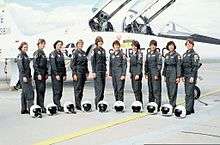
Until the 1970s, aviation had been a traditionally male occupation in the United States. Commerce Department regulations virtually required pilots to have flown in the military to acquire sufficient flight hours, and until the 1970s, the U.S. Air Force and Navy barred women from flying[165] and they were routinely denied work in commercial piloting.[166] The military did not open fighter jet flights to women until 1993.[167] Women eventually began to enter U.S. major commercial aviation in the 1970s and 1980s, with 1973 seeing the first female pilot at a major U.S. airline, American Airlines. American also promoted the first female captain of a major U.S. airline in 1986 and the following year had the first all-woman flight crew.[168] In other countries, women were starting to fly as pilots, such as Turi Widerøe, who was hired in late 1968, for Scandinavian Airlines System and Aeroflot had already hired women pilots.[169]
In the 1970s, women were again, for the first time since WWII, permitted to fly in the United States Armed Forces, beginning with the Navy and the Army in 1974, and then the Air Force in 1976.[170] By the mid-1970s, women were predicting that there would be a large increase in female pilots because of the women's liberation movement.[171] Louise Sacchi was the first international woman ferry pilot who flew planes across the Atlantic and Pacific oceans over 340 times, more than any other non-airline pilot.[172] In 1971 she set a speed record by flying a single-engine land plane from New York to London in 17 hours and 10 minutes, a record that still stands today.[172][173] Sacchi was the first woman to win the Godfrey L. Cabot Award for distinguished service to aviation.[172][174] The first graduating class of ten female Air Force officers earned their Silver Wings on September 2, 1977. These ten women were part of Class 77-08 and graduated at Williams Air Force Base.[175] In 1978, a group of former WASPs formed the Women's Military Pilots Association (WMPA).[176]
In 1975 Yola Cain became the first Jamaican-born commercial pilot and flight instructor.[133] The following year, Cain became the first female pilot with the Jamaica Defence Force and in the 1980s would become the first woman pilot for TransJamaica Ltd. Four years later, in 1979, Jamaican Maria Ziadie-Haddad, became one of the first women in the Western Hemisphere to become a commercial jet airline pilot when she was hired as the first woman pilot of Air Jamaica, as a Boeing 727 second officer.[147] Another Jamaican, Michele Yap became the first female airline captain in the Caribbean flying the Leeward Islands Air Transport's Twin Otter in 1988. The following year, Captain Yap was the first to pilot an all-female crew in the Anglo-Caribbean.[133]
On 9 September 1976 Asli Hassan Abade soloed her first flight as the only female pilot in the Somali Air Force.[148][177] In 1977 Cheryl Pickering-Moore and Beverley Drake of Guyana became the first two women pilots of the Guyana Defence Force.[178] Drake was transferred a few months later as the first female pilot of the Guyana Airways Corporation, she would go on in the 1990s to become the first woman and African-American senior inspection analyst working for the U.S. National Transportation Safety Board.[149] Jill Brown-Hiltz joined Texas International Airlines as a pilot in 1978, becoming the first African American woman to fly for a commercial airline in the United States.[179] That same year, Chinyere Kalu, at the time Chinyere Onyenucheya became Nigeria's first female pilot.[150] In 1979, Koh Chai Hong became the first woman pilot in the Republic of Singapore Air Force (RSAF). Continuing her military career, Koh became one of the first two female Lieutenant-Colonels in 1999.[151] Bahamian Patrice Clarke, later Washington, entered Embry–Riddle Aeronautical University, Daytona Beach in 1979. Three years later she would become the school's first black woman to graduate with a BS in aeronautical science and her commercial pilot's certification.[180] She would go on to become the first woman pilot hired by Bahamasair[181] and later the first black female to command airplanes in the U.S. for a major carrier service when she was promoted to captain by United Parcel Service (UPS) in 1994.[182][183]
Close of the twentieth century

At the close of the century, legal efforts to eliminate barriers of race and sexism in the aviation sector resulted in industry modifications in hiring practices. In the United States, in the late 1970s the Equal Employment Opportunity Commission found violations of the Civil Rights Act of 1964, which the court monitored over the next decades and decreed in 1995 had been sufficiently addressed.[184] In Africa, lack of a strong national carrier resulted in many tourism routes being overtaken by European airlines, but growth in the sector during the 1980s and 1990s saw that 26% of the market share on intercontinental flights were run by Africans.[185] In Latin America and the Caribbean, growth in the tourism sector through the 1990s, led to dramatic expansion of the civil aviation sector, with many countries seeing airport expansions.[186] In military services, women's roles increased during the period in North America, Europe and Asia.[187]
In 1980, Lynn Rippelmeyer of the U.S. became the first woman to fly a Boeing 747 and four years later became the first woman to serve as captain on the craft.[188][189] That same year, Olive Ann Beech was awarded the Wright Brothers Memorial Trophy from the U.S. National Aeronautic Association, for aircraft manufacturing.[190] In 1981, Mary Crawford became the first women's flight officer in the United States Navy[191] and that same year Yichida Ndlovu would earn the first civilian female pilot's license in Zambia.[192] Unable to join the British Royal Air Force or local cadet forces, Elizabeth Jennings Clark of St. Lucia found a private scholarship program to offset the high-cost of training. She became the first female pilot for LIAT when she finished her training in 1983.[193] That same year, Charlotte Larson and Deanne Schulman made history when Larson became the first woman to captain a smoke jumper aircraft and Schulman became the first woman qualified as a smoke jumper.[191]
Khatool Mohammadzai became the first Afghan woman paratrooper in 1984,[194] the same year that Beverly Burns first served as captain on a Boeing 747 for a cross-country trip.[191] In 1986, Rebecca Mpagi joined Uganda's National Resistance Army as its first woman pilot. She would continue to rise in the ranks until by 2008, Mpagi was a Lieutenant Colonel, serving as the head of women affairs for the Uganda People's Defence Force.[195] In 1987, British Airlines hired their first woman pilot, Lynne Barton.[156] and that same year Erma Johnson became the first black and first woman chair of the Dallas/Fort Worth International Airport's Board of Directors.[196] Sakhile Nyoni , a Zimbabwean woman, became the first woman pilot in Botswana in 1988.[197] The following year the Afghan Air Force admitted Latifa Nabizada and her sister, Laliuma, as the first women to train at the military flight school.[198] The sisters would graduate from helicopter school in 1991 becoming the first women Afghani pilots.[199] Canadians Deanne Brasseur and Jane Foster were the first women to fly military aircraft in Canada in 1989.[200]
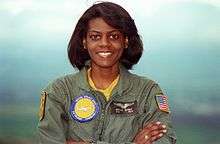
The Royal Air Force lifted their ban on women flying and Sally Cox and Julie Ann Gibson become the first pilots to fly solo in 1990.[156] On July 31 of 1991, the United States Senate lifted the ban on military women flying in combat.[201] By 1998, US military women were flying combat missions from aircraft carriers.[202] In 1992, the first female helicopter pilot to fly in Antarctica was a military officer, Judy Chesser Coffman, of the United States Navy.[203] That same year, Lt. Kelly J. Franke of the United States Navy was the first woman pilot to be awarded the Naval Helicopter Association Pilot of the Year Award.[204] Lt. Franke flew 105 support missions with HSC-2’s Desert Ducks detachment in Bahrain and was cited for extraordinary aviation achievements for 664.2 hours of accident free flight hours.[205] While there were many African American women in the US military, it was 1993 before Matice Wright became the first black woman flight officer in the United States Navy.[206] That same year, Nina Tapula became the first woman military pilot of Zambia.[192][207] Harita Kaur Deol became the first female solo pilot in the Indian Air Force, in September 1994, flying an Avro HS-748 at the age of 22.[208][209] Chipo Matimba became the first woman to complete the Air Force of Zimbabwe's pilot training course in 1996.[210] On December 17, 1998 Kendra Williams was credited as the first woman pilot to launch missiles in combat during Operation Desert Fox.[203] In 1999, Caroline Aigle received the French Air Force's fighter pilot wings and was assigned to fly the Mirage 2000-5.[211]
In the civilian sector, Veronica Foy became the first woman pilot of Malawi in 1992 and by the close of the decade would become Malawi's first woman captain.[212] The first black female Mawalian pilot, Felistas Magengo-Mkandawire began flying as first officer for Air Malawi in 1995.[213] In 1993, Aurora Carandang became the first woman captain for Philippine Airlines.[214] Asnath Mahapa, the first black South African woman, became a pilot in 1998,[215] the same year that Nicole Chang Leng became the first woman pilot of the Seychelles.[216] In November 1998, M'Lis Ward became the first African American woman to captain for a major U.S. commercial airline, United Airlines.[217][183]
More organizations to support women in aviation careers were formed. Women in Aviation International (WAI) formed in 1990 and formalized the organization in 1994.[218][219] WAI went on to establish the Pioneer Hall of Fame to honor women in aviation who had made special contributions to the field.[220] In 1995, the Federation of European Women Pilots (FEWP) was founded in Rome.[221] and two years later the Association for Women in Aviation Maintenance (AWAM) was formed.[222]
Modern day
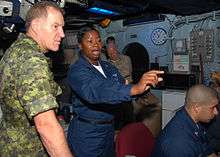
Today women's participation in the aviation sector is still low, but growing. As of 2010, just over 7% of certified civilian pilots (both private and commercial) in the United States were women.[223] As of July 2014, approximately 5.12% of certified airline or commercial pilots in the United States are women.[224] Canada has seen an increase to 18% of women in Royal Canadian Air Force jobs.[225] Overall, in 2008, there were only 16% of women working in the manufacturing of aircraft and spacecraft.[226] Women who work as aerospace engineers made up only 25% in the field in 2014.[227] Women make up less than 6% of senior executive level positions in airline companies, as of 2015.[228]
Pakistani pilot Ayesha Farooq was the first female fighter pilot for the Pakistan Air Force. At least 19 women became pilots in the air force in the decade from 2003.[229] India has been very successful at recruiting women to pilot commercial airliners. In 2014, women made up 11.6% of female pilots. The global average was 3%.[6] Women credit the extended family support systems that exist which help them balance family and career.[6] By 2012, China's PLAAF had trained more than 300 female pilots and over 200 auxiliary air personnel.[132] Large numbers have been trained to fly China's most advanced combat jets, including the J-10.[230] In 2016, ATP-rated instructor pilot Wang Zheng (Julie Wang) became the first Chinese person to pilot an aircraft solo around the world, marking the emergence of women in China's general aviation sector.[231][232]
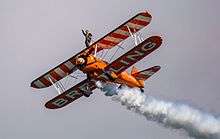
In Japan, the first female captain for commercial passenger flights was Ari Fuji, who began flying as captain for JAL Express in July 2010.[233] In terms of tourism-driven growth in the aviation sector, throughout the Asia-Pacific region, there is a shortage of pilots, which is driving gender biases to be pushed aside for women to be hired. Vietnam Airlines, a major carrier in one of fastest-growing aviation markets, has created flight-schedules that allow flexibility to deal with personal demands. EasyJet Plc provides scholarships for women pilots to help offset the high cost of training and EVA Air has actively recruited candidates from university programs.[234]
In Africa, many of the trained pilots migrate to the Middle East or Asia where opportunities for career advancement and more sophisticated facilities exist. Women Aviators in Africa was founded in 2008 in an attempt to mentor and inspire young women to train in the aviation industry, as estimates for women in the field fall considerably below 6%. Though there is a high level of need across Africa for rural aviation, there is insufficient infrastructure to support expansion. Grass-roots efforts have seen success with training for bush pilots in transport, medical assistance and policing. Efforts are on-going to increase the numbers of women because women are less likely to move to other areas if they as able to find sufficient employment and opportunities in their own communities.[235] As of 2016, seven of the top ten markets in terms of growth-speed of aviation were in Africa.[234]
Sexism
Women often had to work hard to prove themselves as capable as men in the field. Clare Booth Luce wrote, "Because I am a woman, I must make unusual efforts to succeed. If I fail, no one will say, 'She doesn't have what it takes.' They will say, 'Women don't have what it takes.'"[236] Pioneer aviator, Claude Grahame-White felt that women were "not 'temperamentally suited' to handle the controls of an airplane."[237]
During the first National Women's Air Derby in 1929, women flying the race faced "threats of sabotage and headlines that read, 'Race Should Be Stopped.'"[4] Because flying was considered dangerous, many aircraft manufacturers in the late 1920s hired women as sales representatives and flight demonstrators. "The reasoning was that if a woman could fly an airplane, it really could not be that difficult or dangerous."[238][104]
Despite women's participation in airplane aviation from the beginning, in 1986 a spokesperson for the Airline Pilot's Association said that the reason there were only two women Boeing 747 captains at the time was "because women in aviation are a relatively recent phenomenon and everything in the airlines industry is done by seniority".[239] This also ignores the fact that Helen Richey became the first woman to fly a commercial airliner in 1934. She quit that job in ten months because the all-male pilot's union would not admit her and she rarely got to fly.[240]
There are some passengers who will not fly an airplane piloted by a woman. In 1991, a passenger on SN Brussels Airlines refused to fly on a plane piloted by Barbara Collinet.[241] In 2011, an IndiGo Airlines flight was delayed nearly 2 hours because a passenger "caused a ruckus over the fact that the plane's pilot was a woman".[242] Biases toward women's traditional roles with men in the cockpit and women serving beverages and blankets have become ingrained, forcing women who want to fly to struggle with the attitudes of both co-workers and society.[234] In 2016, seven passengers from an American Airlines flight en route from Miami to Buenos Aires disembarked when they learned that their crew was an all-woman crew.[243]
A survey conducted by Mitchell, Krstivics & Vermeulen in 2005 found that many women pilots were either unaware of sexism directed towards them or had not experienced any sexism directly. However, many women believe that more women are experiencing prejudice than are admitting it.[244]
See also
References
Citations
- ↑ Smithsonian Air and Space Museum 2013.
- ↑ Dall'Acqua 1986, p. 1.
- ↑ Olsen 2016.
- 1 2 Gant 2001, pp. 11–12.
- ↑ Goyer 2012.
- 1 2 3 Sinha 2014.
- ↑ Jessen 2002, p. xi.
- ↑ Sinclair 2012, p. 179.
- 1 2 3 4 5 6 Centennial of Women Pilots 2009.
- ↑ Holmes 2013, pp. 4–6.
- ↑ Walsh 1913, p. 12.
- ↑ Ruiz & Korrol 2006, p. 188.
- 1 2 3 4 Women in Aviation International 2003.
- 1 2 3 Wright Brothers Aeroplane Company 2013.
- 1 2 The World Magazine 1909.
- ↑ The Oregon Daily Journal 1909, p. 34.
- ↑ Harrisburg Daily Independent 1908, p. 1.
- ↑ Gabrielli 2003.
- ↑ St. Louis Post-Dispatch 1909, p. 6.
- 1 2 Remington 2006.
- ↑ The New York Times 1909.
- 1 2 3 Branson 2010, p. 110–111.
- 1 2 3 Parachute History 2001.
- ↑ Berghaus 2009, p. 9.
- ↑ Aldrich 2015.
- ↑ Wright Brothers Aeroplane Company 2014, p. 3.
- ↑ Crouch 2003, p. 120.
- ↑ Lebow 2002, p. 277.
- ↑ Lebow 2002, p. 70.
- ↑ Lebow 2002, p. 78.
- 1 2 Air Ambulance International 2013.
- ↑ Dumoulin & Feuillen 2005.
- ↑ Cochrane & Ramirez 2016.
- ↑ Lebow 2002, pp. 204–205.
- ↑ Lebow 2002, pp. 215, 219.
- 1 2 The Pittsburg Daily Headlight 1912, p. 8.
- ↑ Lebow 2002, pp. 220–225.
- ↑ Lebow 2002, p. 226.
- ↑ Smithsonian National Air and Space Museum & August 1, 2016.
- ↑ Lebow 2002, p. 233.
- ↑ Lebow 2002, p. 164.
- ↑ Cochrane & Ramirez 2014.
- ↑ Gribanov 2013, p. 435.
- ↑ Lebow 2002, p. 91.
- ↑ Lebow 2002, p. 69.
- ↑ Lebow 2002, p. 77.
- ↑ Lam 2004.
- ↑ Hartmann 2015, pp. 4–5.
- ↑ Lanza 2013, pp. 110–115.
- ↑ Marcu 2009.
- ↑ Zakharov 1988, pp. 37–49.
- ↑ South African Power Flying Association 2010.
- ↑ Judge 2015, p. 141.
- ↑ Judge 2012, pp. 163–164, 168.
- ↑ Smithsonian National Postal Museum & 2004-B.
- ↑ Smithsonian National Postal Museum & 2004-A.
- ↑ Winged Victory 2006, p. 1910s.
- ↑ Grant 2009.
- ↑ Lebow 2002, p. 86.
- ↑ Branson 2010, p. 108.
- 1 2 3 Folstad 2012.
- 1 2 The Brainerd Daily Dispatch 1921, p. 1.
- ↑ Welshimer 1930, p. 8.
- ↑ Sherman 2008.
- ↑ The Detroit Free Press 1920, p. 5.
- ↑ National Aviation Hall of Fame 2006.
- ↑ Nakamura 2000.
- ↑ Jang Jin Young 2005.
- ↑ Yang & Wu 2006.
- ↑ Centennial of Women Pilots: Etzdorf 2015.
- ↑ Lufthansa 2013.
- ↑ Bednarek & Bednarek 2003, p. 48–49.
- ↑ Gibson 2013, pp. 136–137.
- ↑ Centennial of Women Pilots: Barnes 2015.
- ↑ Jessen 1999.
- ↑ Air Ambulance International n.d.
- ↑ Lebow 2002, p. 42–43.
- ↑ Sissons 2007.
- ↑ Hollander, Jessen & West 1996, pp. 11–12.
- ↑ Bednarek & Bednarek 2003, p. 80.
- ↑ Latson 2015.
- ↑ Molotsky 1985.
- ↑ BBC 2015.
- ↑ Strassmann, W. Paul (2008). The Strassmanns: Science, Politics and Migration in Turbulent Times (1793-1993). New York: Berghahn Books. ISBN 9781845454166.
- ↑ "Antonie Strassmann - German Movie Star, American Entrepreneur, Cosmopolitan Pilot". National Air and Space Museum. 2014-04-11. Retrieved 2018-01-20.
- ↑ Crouch 2003, p. 282.
- ↑ Alden 1932, p. 17.
- ↑ Dall'Acqua 1986, p. 2.
- ↑ Merry 2010, pp. 176–177.
- ↑ Habib 2014.
- ↑ Markwick & Cardona 2012, p. 37.
- ↑ Centennial of Women Pilots: Raskova 2015.
- ↑ Strebe 2007, p. 16.
- ↑ Ferraro 2008.
- ↑ Ying 2012.
- ↑ Kulkarni 2009.
- ↑ Ramachandran 2006.
- ↑ Monash University 2009.
- ↑ Lehmkuhl 2008.
- ↑ Barbera 2005, p. 37.
- ↑ The AOPA Pilot 1962, p. 70.
- ↑ Sofroniou 2013, p. 198.
- ↑ Kirkland 2013, p. 85.
- 1 2 Crouch 2003, p. 308–309.
- ↑ Altınay 2001.
- ↑ Bird & Botes 1982.
- ↑ Best n.d., p. 49.
- 1 2 3 4 Texas Women's University 2013.
- 1 2 Martin 1993.
- ↑ Federal Aviation Administration n.d.
- 1 2 Douglas 2004, p. 135.
- ↑ Shetterly 2016, pp. 7, 11–12.
- ↑ Coetzee 2015.
- ↑ Salt 2015, p. 108.
- ↑ Shaw 1976.
- ↑ Cipalla 1987.
- ↑ Beton Delègue 2011.
- ↑ March 2016.
- ↑ Lee 2008, p. 233.
- ↑ 오마이뉴스 2004.
- ↑ Garber 2013.
- 1 2 Martin 2013.
- 1 2 All About Military 2010.
- ↑ Noggle 2001, pp. 157–158.
- ↑ Jackson 2003, p. 57.
- 1 2 Reis 2013.
- ↑ Rodrigues & de Lima 2009, p. 2.
- ↑ The Ottawa Journal 1951, p. 3.
- ↑ Pidduck 2006.
- ↑ National Institute of Higher Education, Research, Science and Technology n.d.
- ↑ Wallace 2015.
- 1 2 Allen & Kelly 2012.
- 1 2 3 Smalling 1990, p. 50.
- ↑ Douglas 2004, p. 131.
- ↑ Douglas 2004, p. 133.
- ↑ Hwang 2013.
- ↑ Gollob 2005.
- ↑ Bridges & Neal-Smith 2014, p. 168.
- ↑ Weitekamp 2005, pp. 55–56.
- ↑ Shah 2015.
- ↑ Brock University 2006.
- ↑ Smithsonian National Air and Space Museum 2007.
- ↑ Brownlee 2013.
- ↑ Brown 1995.
- 1 2 Southern African Women in Aviation and Aerospace 2012.
- 1 2 République Tunisienne Ministère du Transport 2013.
- 1 2 The Jamaica Observer 2010.
- 1 2 Somali Aviation Resource Center 2013.
- 1 2 McKenzie 2013.
- 1 2 The National Mirror 2014.
- 1 2 Singapore Council of Women's Organisations 2015.
- 1 2 Handy 2014.
- ↑ Variety 1962.
- ↑ Barry 2006.
- ↑ Bridges & Neal-Smith 2014, pp. 168–169.
- 1 2 3 Gough-Cooper 2013.
- ↑ Guyana Chronicle 2014.
- ↑ Tadias Magazine 2010.
- ↑ Weitekamp 2004.
- ↑ Sharp 2013.
- ↑ Knox 2013.
- ↑ Deedes 2001.
- ↑ McLean 2001.
- ↑ Getline 2005.
- ↑ Turner 2011, p. 55.
- ↑ Skogen 2014, p. 16.
- ↑ Anderson 2002.
- ↑ Charlton 1973.
- ↑ Ganson 2015.
- ↑ The Index-Journal 1974, p. 15.
- 1 2 3 The Ninety Nines n.d.
- ↑ Parrack 2006.
- ↑ Aero Club of New England 2011.
- ↑ Swopes 2015.
- ↑ Garwood 2014.
- ↑ BBC 2004.
- ↑ Grainger 2013.
- ↑ Roberts 2015.
- ↑ San Diego Air & Space Museum n.d.
- ↑ Tribune 242 2012.
- ↑ Ho 1995.
- 1 2 Horton 2000, p. 14.
- ↑ Hansen & Oster, Jr. 1997, pp. 117–119.
- ↑ Otieno 2013.
- ↑ West 2001, pp. 307, 401, 419, 526, 699.
- ↑ Becraft 1990.
- ↑ Saathoff 2013.
- ↑ Gibson 2013, p. 145.
- ↑ Farney 2010, pp. 172–174.
- 1 2 3 Gant 2001, p. 12.
- 1 2 GlObserver 2013.
- ↑ Aimable 2014.
- ↑ BBC News Magazine 2013.
- ↑ Okwera 2012.
- ↑ Smith, Bracks & Wynn 2015, p. 473.
- ↑ Bulawayo 24 2011.
- ↑ Sara 2013.
- ↑ Moreau & Yousafzai 2013.
- ↑ Monroe 2004.
- ↑ Schmitt 1991.
- ↑ Colonial Williamsburg Foundation 2008.
- ↑ Bogino 1992
- ↑ Flying 1992, p. 34.
- ↑ Douglas 2004, p. 251.
- ↑ MiCampus Magazine 2016.
- ↑ Ministry of Information and Broadcasting 1998, p. 686.
- ↑ The Indian Express 2008.
- ↑ Girls High School 2015.
- ↑ Catholic News Agency 2007.
- ↑ Twea 2016.
- ↑ Nyasa Times 2016.
- ↑ Philippine Airlines 2015.
- ↑ Humayan, Sealy & Parke 2016.
- ↑ Kreol Magazine 2011.
- ↑ Hughes 2000, pp. 120–124.
- ↑ Flying 1996, p. 44.
- ↑ Flying 1997, p. 35.
- ↑ Flying 2000, p. 44.
- ↑ British Women Pilots' Association Newsletter 2011, p. 19.
- ↑ Florida Department of Transportation 1996.
- ↑ Federal Aviation Administration 2010.
- ↑ Carsenat & Rossini 2014.
- ↑ Parker 2016, pp. 24–27.
- ↑ Poole 2008.
- ↑ Marcus 2014.
- ↑ Centre for Aviation 2015.
- ↑ Ynetnews 2013.
- ↑ Monster Worldwide 2012.
- ↑ Sina Travel 2016.
- ↑ Yahoo! News 2016.
- ↑ Wang 2010.
- 1 2 3 Boudreau & Nguyen 2016.
- ↑ Grant 2011.
- ↑ Gibson 2013, p. 2.
- ↑ Crouch 2003, p. 308.
- ↑ Bednarek & Bednarek 2003, p. 49.
- ↑ Dean 1986, pp. 1–4.
- ↑ Holden 2001.
- ↑ La Libre 2003.
- ↑ The Huffington Post 2011.
- ↑ Lavalle 2016.
- ↑ Civil Aviation Safety Authority Australia 2015.
Bibliography
- Aimable, Anselma (May 27, 2014). "Did You Know: St. Lucia's first female pilot". Castries, St. Lucia: St. Lucia News Online. Archived from the original on 23 April 2015. Retrieved 22 December 2016.
- Alden, Alice (12 August 1932). "'Give Woman Her Place in the Air'". The Evening News. Harrisburg, Pennsylvania. Retrieved 1 December 2016 – via Newspapers.com.
- Aldrich, Nancy W. (May 14, 2015). "Who Was First?: "Pottelsberghe, Peltier, or Berg"". 20th Century Aviation Magazine. Lakeland, Florida. Archived from the original on 17 October 2016. Retrieved 21 December 2016.
- Allen, Kenneth; Kelly, Emma (June 22, 2012). "China's Air Force Female Aviators: Sixty Years of Excellence (1952–2012)". China Brief. Washington, D.C.: Jamestown Foundation. 12 (12). Archived from the original on 18 December 2016. Retrieved 18 December 2016.
- Altınay, Ayşe Gül (25 March 2001). "Dünyanın İlk Kadın Savaş Pilotu: Gökçen" [World's First Women's War Pilot: Gökçen] (in Turkish). Istanbul, Turkey: BİA Haber Merkezi. Bianet. Archived from the original on 13 September 2016. Retrieved 16 December 2016.
- Anderson, Joel (March 26, 2002). "Woman retiring after 26 years with American Airlines". Plainview, Texas: The Plainview Herald. AP. Archived from the original on 26 December 2016. Retrieved 26 December 2016.
- Barbera, Jonathon (2005). Agent of the Gentle Empire with New Technology. New York, New York: iUniverse. ISBN 978-0-595-34719-3.
- Barry, Kathleen M. (2006). "Timeline of Flight Attendants' Fight Against Discrimination". Femininity in Flight. Towson, Maryland. Archived from the original on 26 August 2016. Retrieved 10 December 2016.
- Becraft, Carolyn (1990). "Facts About Women in the Military, 1980–1990". Feminism. Pittsburgh, Pennsylvania: Carnegie Mellon University Women's Center. Archived from the original on 11 May 2016. Retrieved 28 December 2016.
- Bednarek, Janet R. Daly; Bednarek, Michael H. (2003). Dreams of Flight: General Aviation in the United States. College Station, Texas: Texas A&M University Press. ISBN 1-58544-257-7.
- Berghaus, Günter (2009). Futurism and the Technological Imagination. Amsterdam, The Netherlands: Rodopi. ISBN 90-420-2747-9.
- Best, Liz (n.d.). "Patricia Malone helps airline pilots get you there" (PDF). unnamed newspaper clipping. p. 49. Retrieved 15 December 2016.
- Beton Delègue, Elisabeth (20 June 2011). "Discurso de la Embajadora (Condecoración de Margot Duhalde)" [Address by the Ambassador (Decorating Margot Duhalde)]. Amba France (in Spanish). Santiago, Chile: Embajada de Francia en Santiago de Chile. Archived from the original on 7 March 2016. Retrieved 29 December 2016.
- Bird, Marjorie Egerton; Botes, Molly (June 1982). "Flying High: The Story of the Women's Auxiliary Air Force 1939–1945". Military History Journal. Kengray, Johannesburg, South Africa: The South African Military History Society. 5 (5). Archived from the original on 4 March 2016. Retrieved 19 December 2016.
- Branson, Richard (2010). Reach for the Skies: Ballooning, Birdmen, and Blasting Into Space. New York: Penguin Group. ISBN 978-1-61723-003-5.
- Boudreau, John; Nguyen, Giang (April 3, 2016). "Travel Boom Forces Asia's Airlines to Seek More Women Pilots". New York City, New York: Bloomberg Businessweek. Archived from the original on 29 December 2016. Retrieved 29 December 2016.
- Bridges, Donna; Neal-Smith, Jane (2014). Absent Aviators: Gender Issues in Aviation. New York: Routledge. ISBN 978-1-4724-3338-1.
- Brown, Ruth (Autumn 1995). "Racism and immigration in Britain". International Socialism Journal. London, England: Socialist Workers Party (68). ISSN 1754-4653. Retrieved 26 December 2016.
- Brownlee, John (5 December 2013). "What It Was Really Like To Fly During The Golden Age Of Travel". Fast Company Design. New York, New York: Fast Company Magazine. Archived from the original on 13 May 2016. Retrieved 26 December 2016.
- Carsenat, Elian; Rossini, Elena (August 5, 2014). "Airline Pilots: how many women in The Airman Directory?". GenderGapGrader.com. Archived from the original on 21 May 2016. Retrieved August 5, 2014.
- Charlton, Linda (10 June 1973). "Women Pilots". The New York Times. New York City, New York. Retrieved 22 December 2016.
- Cipalla, Rita (March 29, 1987). "Sky's No Limit". Chicago, Illinois: The Chicago Tribune. Smithsonian News Service. Archived from the original on 30 November 2016. Retrieved 30 November 2016.
- Cochrane, D.; Ramirez, P. (2016). "Helene Dutrieu". Air and Space Smithsonian Institution. Washington, D. C.: Smithsonian National Air and Space Museum. Archived from the original on 1 June 2016. Retrieved 30 November 2016.
- Cochrane, D.; Ramirez, P. (2014). "Matilde Moisant". Air and Space Smithsonian Institution. Washington, D. C.: Smithsonian National Air and Space Museum. Archived from the original on 1 June 2016. Retrieved 1 December 2016.
- Coetzee, Anchen (May 6, 2015). "Local female pilot leaves a lasting legacy". Barberton, Mpumalanga, South Africa: Barberton Times. Archived from the original on 19 December 2016. Retrieved 19 December 2016.
- Crouch, Tom D. (2003). Wings: A History of Aviation from Kites to the Space Age. New York, New York: W.W. Norton & Company. ISBN 0-393-05767-4.
- Dall'Acqua, Joyce (23 March 1986). "Women Pilots Built Their Careers on Fear of Flying Companies Hired Them to Prove Safety of Air Travel". Los Angeles Times. Los Angeles, California. p. 1. Archived from the original on 2 December 2016. Retrieved 2 December 2016. and Dall'Acqua, Joyce (23 March 1986). "Women Pilots Built Their Careers on Fear of Flying: Companies Hired Them to Prove Safety of Air Travel". Los Angeles Times. Los Angeles, California. p. 2. Archived from the original on 2 December 2016. Retrieved 2 December 2016.
- Dean, Paul (2 February 1986). "More and More Women Are Finding the Skies Friendly in the Air Force". Los Angeles Times. Los Angeles, California. pp. 1–4. Archived from the original on 26 December 2016. Retrieved 2 December 2016.
- Deedes, W F (3 January 2001). "Mama Daktari's high-flying life of adventure". London, England: The Daily Telegraph. Archived from the original on 10 October 2016. Retrieved 21 December 2016.
- Douglas, Deborah G. (2004). American Women and Flight Since 1940. The University Press of Kentucky. ISBN 0-8131-9073-8.
- Dumoulin, Alphonse; Feuillen, Robert (2005). "Hélène Dutrieu, première aviatrice belge, pionnière de l'aviation féminine, membre d'honneur à titre posthume de la Société royale" [Hélène Dutrieu, first Belgian aviator, pioneer of women's aviation, posthumous honorary member of the Royal Society]. Vieilles Tiges de l'Aviation belge (in French). Brussels, Belgium: Société royale des Pionniers et Anciens de l'Aviation belge. Archived from the original on 25 June 2016. Retrieved 30 November 2016.
- Farney, Dennis (2010). The Barnstormer and the Lady. Kansas City, Missouri: Rockhill Books. ISBN 978-1-935362-69-2.
- Ferraro, Jordan (2008). "Lee Ya-Ching Papers". SOVA Smithsonian Institutions. Chantilly, Virginia: National Air and Space Museum Archives Division. Archived from the original on 18 December 2016. Retrieved 18 December 2016.
- Folstad, Hartley (2012). "Wingwalking History". Silver Wings Wingwalking. Homestead, Florida. Archived from the original on 21 April 2016. Retrieved 1 December 2016.
- Gabrielli, Betty (15 December 2003). "The Wright Stuff". Oberlin Online. Oberlin, Ohio: Oberlin College. Archived from the original on 29 July 2016. Retrieved 29 November 2016.
- Ganson, Barbara (February 21, 2015). "U.S. Women of Military Aviation History Since World War I". Women of Aviation Week. Vancouver, Canada: Institute for Women Of Aviation Worldwide. Archived from the original on 26 December 2016. Retrieved 26 December 2016.
- Gant, Kelli (June 2001). "Women in Aviation" (PDF). Flight Attendant News: 11–12.
- Garber, Megan (15 July 2013). "Night Witches: The Female Fighter Pilots of World War II". The Atlantic. Archived from the original on 23 June 2016. Retrieved 1 December 2016.
- Garwood, Barbara (2014). "Women Military Aviators Digital Archive". Gateway to Women's History. Texas Woman's University. Archived from the original on 2 April 2015. Retrieved 28 December 2016.
- Getline, Meryl (March 1, 2005). "Becoming a female pilot: then and now". McLean, Virginia: USA Today. Archived from the original on 1 February 2014. Retrieved 2012-05-18.
- Gibson, Karen Bush (2013). Women Aviators: 26 Stories of Pioneer Flights, Daring Missions and Record-Setting Journeys. Chicago, Illinois: Chicago Review Press. ISBN 978-1-61374-540-3.
- Gollob, Beth (May 10, 2005). "Korean aviator honored Kyung Kim was the first female military flier in her native country". Oklahoma City, Oklahoma: NewsOK. Retrieved 19 December 2016.
- Gough-Cooper, Caroline (17 July 2013). "Celebrating 100 Years of British Women Pilots". British Women Pilots' Association. Maidenhead, Berkshire, England. Archived from the original on 26 December 2016. Retrieved 26 December 2016.
- Goyer, Mireille (2012). "Five decades of female pilots statistics in the United States. How did we do?". Women of Aviation Week. Vancouver, Canada: Institute for Women Of Aviation Worldwide. Archived from the original on 6 May 2016. Retrieved 28 November 2016.
- Grainger, Sharmain (31 March 2013). "Paving the way for women pilots, Cheryl Moore is a 'Special Person'". Georgetown, Guyana: Kaieteur News. Archived from the original on 4 March 2016. Retrieved 27 December 2016.
- Grant, Alistair (2009). "Hilda Beatrice Hewlett". The Elmbridge Hundred. Elmbridge, England: Elmbridge Borough Council. Retrieved 3 December 2016.
- Grant, Chloe (11 October 2011). "Women Can Stem The Braindrain Crisis". Aviation & Allied Business Journal. Lagos, Nigeria: Landover Company Limited. Archived from the original on 26 December 2016. Retrieved 26 December 2016.
- Грибанов (Gribanov), Станислав (Stanislav) (2013). Пилоты Его Величества (in Russian). Moscow, Russia: Центрполиграф. ISBN 978-5-457-02911-8.
- Habib, Nader (23 October 2014). "Once upon a time—She wanted to be free" (1218). Cairo, Egypt: Al-Ahram Weekly. Archived from the original on 16 December 2016. Retrieved 17 December 2016.
- Handy, Bruce (May 28, 2014). "Glamour With Altitude". Vanity Fair. New York City, New York: Condé Nast. Archived from the original on 2 May 2016. Retrieved 6 December 2016.
- Hansen, Janet S.; Oster, Jr., Clinton V. (1997). Taking Flight: Education and Training for Aviation Careers. Washington, D.C.: National Academies. NAP:15655.
- Hartmann, Gérard (2 September 2015). "Jane Herveu, le risque pour compagnie" [Jane Herveu, Risk for Company] (PDF). Hydroretro (in French). Archived from the original (PDF) on 2 December 2016. Retrieved 2 December 2016.
- Ho, Rodney (12 February 1995). "Black Woman Pilot A Role Model". Chicago, Illinois: The Chicago Tribune. Archived from the original on 24 October 2015. Retrieved 23 December 2016.
- Holden, Henry M. (2001). "Helen Richey: First Female Airline Pilot". Women In Aviation Resource Center. New Jersey: Black Hawk Publishing. Retrieved 2 December 2016.
- Hollander, Lu; Jessen, Gene Nora; West, Verna, eds. (1996). The Ninety-Nines: Yesterday, Today, Tomorrow. Paducah, Kentucky: Turner Publishing Company. ISBN 978-1-56311-203-4.
- Holmes, Richard (2013). Falling Upwards: How We Took to the Air. New York, New York: Knopf Doubleday Publishing Group. ISBN 978-0-307-90870-4.
- Horton, Phyllis R., ed. (February 2000). "M'Lis Ward: First Black Female Captain in Commercial Aviation". Ebony. Chicago, Illinois: Johnson Publishing Company. 55 (4): 14. ISSN 0012-9011. Retrieved 23 December 2016.
- Hughes, Zondra (January 2000). "M'Lis Ward: First Black Female Captain in Commercial Aviation". Ebony. Chicago, Illinois: Johnson Publishing Company. 55 (3): 120–124. ISSN 0012-9011. Retrieved 23 December 2016.
- Humayan, Hira; Sealy, Amanda; Parke, Phoebe (23 August 2016). "South Africa's first black female pilot is helping other African women take off". CNN. Atlanta, Georgia. Archived from the original on 20 December 2016. Retrieved 12 December 2016.
- 황 (Hwang), 유진 (Youjin) (25 July 2013). "'민간항공의 어머니' 김경오" ['Civil Aviation's Mother' Kim Kyung-oh]. The Korea Herald (in Korean). Archived from the original on 19 December 2016. Retrieved 18 December 2016.
- Jackson, Robert (2003). Air aces of World War II (1st ed.). Wiltshire, England: Airlife. ISBN 1-84037-412-8.
- チャン・ジニョン (Jang Jin Young) (2005-10-16). "映画『青燕』、韓国初の女性飛行士めぐり論争" [Movie 'Blue Swallow' and the debate about Korea's first female aviator]. Chosun Online (in Korean). Archived from the original on 30 September 2007. Retrieved 2007-05-22.
- Jessen, Gene Nora (1999). "1929 Air Race". 99 News Magazine. Oklahoma City, Oklahoma: The Ninety-Nines: International Organization of Women Pilots (Special). Archived from the original on 16 November 2016. Retrieved 26 November 2016.
- Jessen, Gene Nora (2002). Powder Puff Derby of 1929. Naperville, Illinois: Sourcebooks, Inc. ISBN 978-1-4022-2972-5.
- Judge, Joan (2015). "The Fate of the Late Imperial "Talented Woman": Gender and Historical Change in Early-Twentieth-Century China". In Bossler, Beverly Jo. Gender and Chinese History: Transformative Encounters. Seattle, Washington: University of Washington Press. pp. 139–160. ISBN 978-0-295-80601-3.
- Judge, Joan (2012). "Portraits of Republican Ladies: Materiality and Representation in Early Twentieth Century Chinese Photographs". In Henriot, Christian; Yeh, Wen-hsin. Visualising China, 1845–1965: Moving and Still Images in Historical Narratives. Leiden, the Netherlands: BRILL. pp. 131–170. ISBN 978-90-04-23375-1.
- Kirkland, Richard C. (2013). Tales of a Helicopter Pilot. History of Aviation. Washington, D. C.: Smithsonian Institution. ISBN 978-1-58834-413-7.
- Knox, Annie (4 May 2013). "50 years later, pilot looks back on record journey". Salt Lake City, Utah: KSL Broadcasting. Associated Press. Archived from the original on 4 March 2016. Retrieved 26 December 2016.
- Kulkarni, Jayant (November 25, 2009). "Remember Sarla Thakral's maiden flight of fancy". Mumbai, India: Daily News and Analysis. Archived from the original on 4 November 2013. Retrieved 2013-10-09.
- Lam, Dave (November 14, 2004). "Bozena Laglerova". Early Aviators. The Early Birds of Aviation, Inc. Archived from the original on 27 September 2012. Retrieved 30 November 2016.
- Lanza, Maurizio (2013). "Rosina Ferrorio: Primo donne ovioirice in Italia" [Rosina Ferrorio: First woman aviatrix in Italy] (PDF). Rivista Aeronautica (in Italian). Rome, Italy: Ministero Della Difesa. 110 (1): 110–115. ISSN 0391-6162. Archived from the original (PDF) on 2 December 2016. Retrieved 2 December 2016.
- Latson, Jennifer (May 15, 2015). "Hired for Their Looks, Promoted For Their Heroism: The First Flight Attendants". New York City, New York: Time. Archived from the original on 16 September 2016. Retrieved 2 December 2016.
- Lavalle, Cecilia (20 July 2016). "¿Es tan difícil?" [Is it so difficult?] (in Spanish). Tijuana, Mexico: Ciudad Tijuana. Archived from the original on 7 August 2016. Retrieved 31 December 2016.
- Lebow, Eileen F. (2002). Before Amelia: Women Pilots in the Early Days of Aviation. Washington, DC: Potomac Books, Inc. ISBN 978-1-57488-482-1.
- Lee, Bae-yong (2008). Women in Korean History. Seoul, Korea: Ewha Womans University Press. ISBN 978-89-7300-772-1.
- Lehmkuhl, Anne (1 September 2008). "A Tribute To An Aviation Pioneer". Bygones and Byways. South Africa. Archived from the original on 19 December 2016. Retrieved 19 December 2016.
- March, William (5 January 2016). "RCAF (Women's Division)". The Canadian Encyclopedia. Alberta, Canada: Historica Canada. Archived from the original on 10 May 2016. Retrieved 16 December 2016.
- Marcu, George (2009). "Elena Caragiani-Stoenescu". Enciclopedia României (in Romanian). Bucureşti, Romania: Editura Meronia. Archived from the original on 16 May 2016. Retrieved 3 December 2016 – via Dicţionarul personalităţilor feminine din România.
- Marcus, Bonnie (29 October 2014). "Women In Aerospace: Challenges And Opportunities". Forbes. Jersey City, New Jersey. Archived from the original on 22 December 2016. Retrieved 14 December 2016.
- Martin, Douglas (14 July 2013). "Nadezhda Popova, WWII 'Night Witch,' Dies at 91". The New York Times. New York City, New York. Archived from the original on 20 June 2016. Retrieved 1 December 2016.
- Martin, Hugo (21 August 1993). "Women Pioneers of Aviation to Be Saluted at Airport Expo". Los Angeles Times. Los Angeles, California. Retrieved 2 December 2016.
- Markwick, Roger D.; Cardona, Euridice Charon (2012). Soviet Women on the Frontline in the Second World War. New York, New York: Palgrave MacMillan. ISBN 978-0-230-36254-3.
- McKenzie, Nigel (June 9, 2013). "Pilot, analyst and administrator, Beverley Drake, is a 'Special Person'". Georgetown, Guyana: Kaieteur News. Archived from the original on 27 December 2013. Retrieved 22 December 2016.
- McLean, Jacqueline (2001). Modern Women in Aviation. Ipswich, Massachusetts: MasterFILE Premier. ISBN 978-1-881508-70-0 – via EBSCOhost. (Subscription required (help)).
- Merry, Lois K. (2010). Women Military Pilots of World War II: A History with Biographies of American, British, Russian and German Aviators. Jefferson, North Carolina: McFarland. ISBN 978-0-7864-5768-7.
- Ministry of Information and Broadcasting (1998). India: A Reference Annual. New Delhi, India: Publications Division, Ministry of Information and Broadcasting. ISBN 978-81-230-0637-6.
- Molotsky, Irvin (12 November 1985). "Pioneers: Women Who Led the Way in Aviation". The New York Times. New York City, New York. Retrieved 2 December 2016.
- Monroe, Dawn E. (2004). "Famous Canadian Women's Famous Firsts". Famous Canadian Women. Archived from the original on 2 April 2016. Retrieved 28 December 2016.
- Moreau, Ron; Yousafzai, Sami (13 August 2013). "Afghanistan's Amelia Earhart". The Daily Beast. New York, New York. Archived from the original on 22 December 2016. Retrieved 28 December 2016.
- 中村 (Nakamura), 英利子 (Yuko) (2000). 兵頭精、空を飛びます!: 日本人初の女性パイロットの物語 [Hyōdō Tadashi, I will fly in the sky!: The story of Japan's first female pilot] (in Japanese). Matsuyama, Ehime, Japan: アトラス出版. ISBN 978-4-901108-10-2.
- Noggle, Anne (2001). A Dance With Death: Soviet Airwomen in World War II. College Station, Texas: Texas A&M University Press. ISBN 978-1-58544-177-8.
- Okwera, Oyet (13 June 2012). "Mpagi: Uganda's first woman military pilot". Kampala, Uganda: New Vision. Archived from the original on 10 May 2016. Retrieved 28 December 2016.
- Olsen, Patricia R. (12 November 2016). "Putting Together the Engines That Help Big Birds Take Wing". The New York Times. New York City, New York. Retrieved 2 December 2016.
- Otieno, Lynet (25 November 2013). "Africa's aviation industry lagging behind". Nairobi, Kenya: The Standard. Archived from the original on 4 February 2014. Retrieved 28 December 2016.
- Parker, Gillian (April 2016). "The Canadian Women in Aviation Conference: Outdated or Essential?". Airforce Magazine. 39 (4): 24–27 – via EBSCOhost. (Subscription required (help)).
- Parrack, Keely (March 7, 2006). "For pilots, the sky's the limit". Boston, Massachusetts: The Christian Science Monitor. Archived from the original on 3 March 2016.
- Pidduck, Angela (January 29, 2006). "TT's first female pilot". Port of Spain, Trinidad: Trinidad and Tobago Newsday. Archived from the original on 14 February 2016. Retrieved 30 November 2016.
- Poole, Dan (8 May 2008). "All things being unequal: Women in aerospace". The Independent. London, England. Archived from the original on 20 December 2016. Retrieved 14 December 2016.
- Ramachandran, Smriti Kak (February 5, 2006). "Flying colours & ground reality". Chandigarh, India: The Tribune. Archived from the original on 4 March 2016. Retrieved 2013-10-09.
- Reis, Ricardo (October 1, 2013). "The flying Brazilian". Up Magazine. Lisbon, Portugal: TAP Portugal. Archived from the original on 13 April 2014. Retrieved 16 December 2016.
- Remington, Steve (2006). "Miss Todd's Aeroplane". Early Aviators. The Early Birds of Aviation, Inc. Archived from the original on 3 March 2016. Retrieved 1 December 2016.
- Roberts, Chelle (25 February 2015). "Women in Black History With a Passion for Travel". Brown Girls Fly. Archived from the original on 8 May 2016. Retrieved 26 November 2016.
- Rodrigues, Luiz Eduardo Miranda José; de Lima, Cristiane Correia (2009). "Mulheres Aviadoras, o Pioneirismo de Ada Rogato e Seus Feitos Históricos na Aviação Brasileira" [Women Aviators, the Pioneering Ada Rogato and Her Historical Mark on Brazilian Aviation] (PDF). Revista Eletrônica AeroDesign (in Portuguese). São Paulo, Brazil: Instituto Federal de Educação. 1 (1). Retrieved 16 December 2016.
- Ruiz, Vicki L.; Korrol, Virginia Sánchez (2006). Latinas in the United States, set: A Historical Encyclopedia. Bloomington, Indiana: Indiana University Press. ISBN 0-253-11169-2.
- Saathoff, Corey (February 20, 2013). "Valmeyer native in rarefied air as pilot". Waterloo, Iowa: The Republic-Times. Archived from the original on May 22, 2013. Retrieved 28 December 2016.
- Sara, Sally (28 June 2013). "Meet Latifa Nabizada, Afghanistan's First Woman Military Helicopter Pilot". Mama Asia. Sydney, Australia: ABC. Archived from the original on 28 December 2016. Retrieved 29 November 2016.
- Salt, Beryl (2015). A Pride of Eagles: A History of the Rhodesian Air Force (2nd ed.). Solihull, England: Helion and Company. ISBN 978-1-908916-26-6.
- Schmitt, Eric (1 August 1991). "Senate Votes to Remove Ban On Women as Combat Pilots". The New York Times. New York City, New York. Archived from the original on 7 March 2016. Retrieved 2 December 2016.
- Shah, Bina (8 June 2015). "How High Can Pakistan's Air Force Women Fly?". The New York Times. New York City, New York. Archived from the original on 12 June 2015. Retrieved 3 December 2016.
- Sharp, Tim (June 14, 2013). "Valentina Tereshkova: First Woman in Space". Space. New York City, New York: Purch Group. Archived from the original on 11 November 2016. Retrieved 6 December 2016.
- Shaw, Charles Scott (June 1976). "Was Captain Rosamund Everard-Steenkamp the first woman in the world to fly a jet?". Military History Journal. Kengray, Johannesburg, South Africa: The South African Military History Society. 3 (5). Archived from the original on 10 March 2016. Retrieved 19 December 2016.
- Sherman, Janann (March 29, 2008). "Aviation pioneer Phoebe Fairgrave Omlie". Woman Pilot. Chicago, Illinois: Woman Pilot Magazine. Archived from the original on 12 November 2016. Retrieved 1 December 2016.
- Shetterly, Margot Lee (2016). Hidden Figures: The American Dream and the Untold Story of the Black Women Mathematicians Who Helped Win the Space Race. New York, New York: HarperCollins. ISBN 978-0-06-236361-9.
- Sinclair, Michele (2012). A Woman Made For Pleasure. New York City, New York: Zebra Books. ISBN 978-1-4201-2854-3.
- Sinha, Saurabh (24 November 2014). "Indian Women Pilots Soar Past Global Average". Times of India. Mumbai, India. Archived from the original on 13 July 2015. Retrieved 2 December 2016.
- Sissons, Crystal (18 December 2007). "Elsie MacGill". The Canadian Encyclopedia. Alberta, Canada: Historica Canada. Archived from the original on 16 December 2016. Retrieved 12 December 2016.
- Skogen, Jenny (2014). Yes She Did!: Aerospace. La Jolla, California: Scobre Educational. ISBN 978-1-62920-327-0.
- Smalling, Joan (3 September 1990). "Five Women Who Fly". Flair Magazine. Kingston, Jamaica: Gleaner Company: 50. Retrieved 17 December 2016 – via Newspaperarchive.com.

- Smith, Jessie Carney; Bracks, Lean'tin; Wynn, Linda T. (2015). The Complete Encyclopedia of African American History. Canton, Michigan: Visible Ink Press. ISBN 978-1-57859-583-9.
- Sofroniou, Andreas (2013). Technology, A Study of Mechanical Arts and Applied Sciences. Lulu.com. ISBN 978-1-291-58550-6.
- Strebe, Amy Goodpaster (2007). Flying for Her Country: The American and Soviet Women Military Pilots of World War II. Westport, Connecticut: Greenwood Publishing Group. ISBN 978-0-275-99434-1.
- Swopes, Brian R. (2015). "2 September 1977: Class 77-08". Women in Aerospace History. Archived from the original on 28 December 2016. Retrieved 28 December 2016.
- Turner, Denice (2011). Writing the Heavenly Frontier: Metaphor, Geography, and Flight Autobiography in America 1927–1954. Costerus New Series 187. Amsterdam, The Netherlands: Rodopi. ISBN 90-420-3297-9.
- Twea, Brenda (29 March 2016). "Flying the Malawi Flag High". Blantyre, Malawi: The Nation. Archived from the original on 10 April 2016. Retrieved 21 December 2016.
- Wallace, Kimberley (October 16, 2015). "The First Female Captain". Port of Spain, Trinidad: Daily Express. Archived from the original on 8 February 2016. Retrieved 30 November 2016.
- Walsh, William (1913). A Handy Book of Curious Information. Philadelphia, Pennsylvania: J. B. Lippincott Company. OCLC 81150560.
- Wang, Yexing (17 July 2010). "First female captain no quitter". Minato, Tokyo, Japan: Kyodo News. Archived from the original on 20 July 2010 – via Japan Times.
- Weitekamp, Margaret A. (August 3, 2004). "First Lady Astronaut Trainees". History NASA. Washington, D.C.: National Aeronautics and Space Administration. Archived from the original on 29 April 2015. Retrieved 6 December 2016.
- Weitekamp, Margaret A. (2005). Right Stuff, Wrong Sex: America's First Women in Space Program. Baltimore, Maryland: Johns Hopkins University Press. ISBN 978-0-8018-8394-1.
- Welshimer, Helen (April 26, 1930). "Flying Husbands and Wives". Benton-Harbor, Michigan: The News-Palladium. Retrieved 1 December 2016 – via Newspapers.com.

- West, Jacqueline, ed. (2001). South America, Central America and the Caribbean 2002 (10th ed.). London, England: Europa Publications. ISBN 978-1-85743-121-6.
- 杨 (Yang), 理锐 (Li Rui); 吴 (Wu), 文娟 (Wenjuan) (9 March 2006). ""韩国空军祖母"是我师姐" ["Grandma of the Korean Air Force" was my oldest sister's apprentice] (in Chinese). Kunming, China: 昆明新聞 (Kunming News). Archived from the original on 13 May 2008. Retrieved 3 December 2016.
- 影 (Ying), 苏 (Su) (13 April 2012). "中国首位女飞行员是广东美女:与胡蝶周璇并称七姐妹" [Guangdong, China's first female pilots are beauties: the butterfly, Zhou Xuan, and those called the seven sisters] (in Chinese). Guangzhou, Guangdong, China: 羊城晚报 (Yangcheng Evening News). Xinhua News Agency. Archived from the original on 25 September 2013. Retrieved 18 December 2016.
- Zakharov, Vladimir Petrovich (1988). "Из племени крылатых". Первый военный аэродром (The first military airfield) [Of the Winged Tribe] (in Russian). Moskva: Voen. izd-vo. pp. 37–49. ISBN 5-203-00540-0. Archived from the original on 2 December 2016.
- "19 Year old Woman becomes Africa's Youngest Pilot". MiCampus Magazine. July 16, 2016. Archived from the original on 21 December 2016. Retrieved 21 December 2016.
- "100 Most Influential Women in the Aviation and Aerospace Industry". Women in Aviation International. West Alexandria, Ohio. December 17, 2003. Archived from the original on 30 November 2016. Retrieved 29 November 2016.
- "1910 to 1920—Early Flying in South Africa". SAPFA. Cape Town, South Africa: South African Power Flying Association. 2010. Archived from the original on 10 April 2016. Retrieved 12 December 2016.
- "1970s: Turi Widerøe takes the world by storm". Scandinavian Traveler. Solna, Sweden. 24 June 2016. Archived from the original on 23 December 2016. Retrieved 22 December 2016.
- "1979—Jamaica's First Female Commercial Jet Airline Pilot". Kingston, Jamaica: The Jamaica Observer. March 21, 2010. Archived from the original on 24 December 2015. Retrieved 17 December 2016.
- "2010 U.S. Civil Airmen Statistics". Washington, D. C.: Federal Aviation Administration. May 2, 2010. Archived from the original on 6 October 2014. Retrieved May 11, 2012.
- "Air Travel and Segregation". Air and Space. Washington, D.C.: Smithsonian National Air and Space Museum. 2007. Archived from the original on 1 June 2016. Retrieved 26 December 2016.
- "The American Girl Who All Europe is Watching". The World Magazine. West Milton, Ohio. 11 April 1909. Archived from the original on 29 April 2016. Retrieved 29 November 2016 – via Wright Brothers Aeroplane Company.
- "AOPA China Honors Julie Wang (Wang Zheng), First Chinese Person to Fly Solo Around-the-World, at AirShow China 2016". Sunnyvale, California: Yahoo! News. Business Wire. 1 December 2016. Archived from the original on 26 December 2016. Retrieved 26 December 2016.
- "Aviation Chronology". Winged Victory. Women in Aviation Web Magazine. 2006. Archived from the original on 8 September 2011. Retrieved 3 December 2016.
- "Aviation Professional Organizations". Florida Department of Transportation. Tallahassee, Florida. 1996. Archived from the original on 29 December 2016. Retrieved 29 December 2016.
- "Awards: The History of the Godfrey L. Cabot Award Recipients". ACONE. Boston, Massachusetts: Aero Club of New England. 2011. Archived from the original on 19 September 2016. Retrieved 26 December 2016.
- "Bi-plane pilot in Amy Johnson UK to Australia flight". London, England: BBC. 1 October 2015. Archived from the original on 30 July 2016. Retrieved 16 December 2016.
- "Captain Chinyere O. Kalu: Nigeria's first female pilot". Lagos, Nigeria: The National Mirror. January 24, 2014. Archived from the original on 13 August 2014. Retrieved 19 December 2016.
- "China's Female J-10 Fighter Pilots". Military.com. Weston, Massachusetts: Monster Worldwide. August 16, 2012. Archived from the original on 30 May 2016.
- "中国首位环飞女飞行员王争:华人女首飞书写航空传奇" [China's first female pilot Wang Zheng: Chinese women's first flight to write aviation legend]. 新浪旅游 (Sina Travel) (in Chinese). Beijing, China: Sina Corp. 5 December 2016. Archived from the original on 26 December 2016. Retrieved 2016-12-20.
- "Coleman, Bessie". National Aviation Organization. Dayton, Ohio: The National Aviation Hall of Fame. 2006. Archived from the original on 30 November 2016. Retrieved 30 November 2016.
- "Dorothy Rungeling fonds RG 517". Digital Repository. St. Catharines, Ontario, Canada: Brock University. 2006. Archived from the original on 6 August 2016. Retrieved 26 December 2016.
- "Ethiopian Airlines Appoints First Female Captain". New York, New York: Tadias Magazine. 15 October 2010. Retrieved 20 December 2016.
- "Federation of European Women Pilots (FEWP) Annual Congress" (PDF). British Women Pilots' Association Newsletter. Weybridge, Surrey, England: British Women Pilots' Association (99): 19. Summer 2011. Archived from the original (PDF) on 9 August 2016. Retrieved 29 December 2016.
- "Female pioneer pilot impressed with transformation of local aviation industry". Georgetown, Guyana: Guyana Chronicle. November 16, 2014. Archived from the original on 18 December 2016. Retrieved 18 December 2016.
- "Femme Pilote, Une Evolution Naturelle" [A Woman Pilot, a Natural Evolution]. La Libre (in French). Brussels, Belgium. 16 August 2003. Archived from the original on 8 February 2016. Retrieved 28 December 2016.
- "First Female Air Ambulance Pioneer—Marie Marvingt". Houston, Texas: Air Ambulance International. October 15, 2013. Archived from the original on 1 December 2016. Retrieved 1 December 2016.
- "First Ladies of Aviation Seek More Safety". The Index-Journal. Greenwood, South Carolina. 31 August 1974. Retrieved 1 December 2016 – via Newspapers.com.
- "The First Women Controllers" (PDF). Federal Aviation Administration. Washington, D. C.: U.S. Department of Transportation. n.d.
- "Florence Lowe Barnes—USA". Centennial of Women Pilots. Vancouver, Canada: Institute for Women Of Aviation Worldwide. July 25, 2015. Archived from the original on 25 March 2016. Retrieved 1 December 2016.
- "Flying the flag for Somali peace". London, England: BBC. 7 October 2004. Archived from the original on 4 March 2016. Retrieved 20 December 2016.
- "From fighter pilot to courageous mother: the story of Caroline Aigle". Denver, Colorado: Catholic News Agency. 26 September 2007. Archived from the original on 22 December 2016. Retrieved 29 December 2016.
- "Girl's Nerve Unshaken by Tinney Death". Detroit, Michigan: The Detroit Free Press. September 7, 1920. Retrieved 1 December 2016 – via Newspapers.com.

- "Head in the Clouds, Feet on the Ground Seychelles Women Who Excel". Kreol Magazine. London, England: Rila Publications Ltd. October 2, 2011. Archived from the original on 4 April 2016. Retrieved 20 December 2016.
- "Hemisphere Hopper from Rio Reaches Ottawa". Ottawa, Ontario, Canada: The Ottawa Journal. 27 August 1951. Retrieved 16 December 2016 – via Newspapers.com.

- "Highlights of Louise Sacchi's Aviation History". Oklahoma City, Oklahoma: The Ninety Nines. n.d. Archived from the original on 14 May 2008.
- "History and Milestone". Philippine Airlines. Pasay City, The Philippines. 2015. Archived from the original on 31 March 2016. Retrieved 28 December 2016.
- "The History of Somali Aviation Resource Center". Somavires. Mogadishu, Somalia: Somali Aviation Resource Center. 2013. Archived from the original on 11 April 2013. Retrieved 20 December 2016.
- "How Much the Wright Brothers Owe to Their Sister Katherine". The Oregon Daily Journal. Portland, Oregon. 6 June 1909. Retrieved 29 November 2016 – via Newspapers.com.
- "IndiGo Airlines Passenger Refuses To Fly With Female Pilot". The Huffington Post. 25 February 2011. Archived from the original on 11 March 2016. Retrieved 28 December 2016.
- "In the Lufthansa cockpit 25 years on". Lufthansa. Cologne, Germany: Lufthansa Group. 22 August 2013. Archived from the original on 29 September 2014. Retrieved 30 November 2016.
- "Katherine Wright". Wright Brothers Organization. West Milton, Ohio: Wright Brothers Aeroplane Company. 2013. Archived from the original on 29 April 2016. Retrieved 29 November 2016.
- "Koh Chai Hong". Singapore Women's Hall of Fame. Singapore: Singapore Council of Women's Organisations. 2015. Archived from the original on 5 March 2016. Retrieved 26 December 2016.
- "Latifa Nabizada—Afghanistan's First Woman of the Skies". BBC News Magazine. London, England. 19 June 2013. Archived from the original on 20 December 2016. Retrieved 3 December 2016.
- "L'Hommage Historique de Tunisair aux Femmes" [Tunisair's Historic Tribute to Women]. Office de l'Aviation Civile et des Aeroports (in French). Tunis, Tunisia: République Tunisienne Ministère du Transport. 15 August 2013. Archived from the original on 30 August 2013. Retrieved 20 December 2016.
- "식민지 조선의 여자비행사로 산다는 것" [Living as a female aviator in colonial Korea] (in Korean). Seoul, Korea: 오마이뉴스 (OhmyNews). 1 April 2004. Archived from the original on 6 March 2016. Retrieved 19 December 2016.
- "Marga von Etzdorf—Germany". Centennial of Women Pilots. Vancouver, Canada: Institute for Women Of Aviation Worldwide. July 25, 2015. Archived from the original on 8 December 2015. Retrieved 30 November 2016.
- "Marie Marvingt: Air Ambulance Pioneer". Houston, Texas: Air Ambulance International. n.d. Archived from the original on 5 December 2016. Retrieved 3 December 2016.
- "Marina Mikhailovna Raskova—Russia". Centennial of Women Pilots. Vancouver, Canada: Institute for Women Of Aviation Worldwide. July 25, 2015. Archived from the original on 14 December 2016. Retrieved 16 December 2016.
- "Meet Pakistan's first female fighter pilot". Tel Aviv, Israel: Ynetnews. Reuters. 19 June 2013. Archived from the original on 4 March 2016. Retrieved 26 December 2016.
- "Miss Phoebe Fairgrave". Brainard, Minnesota: The Brainerd Daily Dispatch. 7 September 1921. Retrieved 1 December 2016 – via Newspapers.com.

- "Nancy Bird-Walton, O.B.E (1915–2009)". Monash University. Melbourne, Victoria, Australia: Hargrave Aviation and Aeromodelling. 26 May 2009. Archived from the original on 3 August 2016. Retrieved 16 December 2016.
- "On This Day: First U.S. Female to Earn Pilot's License". Air and Space Smithsonian Institution. Washington, D. C.: Smithsonian National Air and Space Museum. August 1, 2016. Archived from the original on 30 November 2016. Retrieved 30 November 2016.
- "Pilot Stories: Ruth Law". Postal Museum. Washington, D. C.: Smithsonian National Postal Museum. 2004. Archived from the original on 21 July 2016. Retrieved 30 November 2016.
- "Pilot Stories: The Stinsons". Postal Museum. Washington, D. C.: Smithsonian National Postal Museum. 2004. Archived from the original on 21 July 2016. Retrieved 30 November 2016.
- "Profile for Captain Chipo M. Matimba". Girls High School. Harare, Zimbabwe: Girls High School, Harare. 2015. Archived from the original on 23 December 2015. Retrieved 20 December 2016.
- "Review: 'Come Fly with Me'". Los Angeles, California: Variety. December 31, 1962. Archived from the original on 10 June 2016. Retrieved 6 December 2016.
- "SAWIA Profiles & Celebrates Pioneering Women in Aviation & Aerospace from the African Continent". Pretoria, South Africa: Southern African Women in Aviation and Aerospace. July 30, 2012. p. 5. Retrieved 19 December 2016.
- "Sister Who Glories in Wrights' Air Triumphs". St. Louis Post-Dispatch. St. Louis, Missouri. 22 March 1909. Retrieved 29 November 2016 – via Newspapers.com.
- "Those Whirly-Girls". The AOPA Pilot. Frederick, Maryland: Aircraft Owners and Pilots Association. 5: 70–72. 1962.
Hanna Reitsch of Frankfurt, Germany, who was the world's first helicopter pilot—man or woman ...
- "Time Line: Women in the U.S. Military" (PDF). History.org. Williamsburg, Virginia: Colonial Williamsburg Foundation. 2008. Archived from the original (PDF) on 20 December 2016. Retrieved 10 December 2016.
- "Tiny Broadwick". Parachute History. 2001. Archived from the original on 16 September 2016. Retrieved 1 December 2016.
- "To Be Near Brother Katherine Wright is Making Home Near Hospital". Harrisburg Daily Independent. Harrisburg, Pennsylvania. 19 September 1908. Retrieved 29 November 2016 – via Newspapers.com.
- "Trio Of Female Captains Make History". Nassau, The Bahamas: Tribune 242. 23 May 2012. Archived from the original on 12 September 2012. Retrieved 23 December 2016.
- "Two Malawi female pilots: Steady take-off". San Francisco, California: Nyasa Times. 10 March 2016. Archived from the original on 19 July 2016. Retrieved 21 December 2016.
- "WAI Seeks Nominees for Hall of Fame". Flying. New York, New York: Hachette Filipacchi Magazines. 127 (9): 44. September 2000. ISSN 0015-4806. Retrieved 29 December 2016.
- "Wake up Call: The Decade After: Nov 1905 to Oct 1909". Wright Brothers Organization. West Milton, Ohio: Wright Brothers Aeroplane Company. 2014. Archived from the original on 18 November 2016. Retrieved 21 December 2016.
- "Wendy Yawching". NIHERST. St Augustine, Trinidad: National Institute of Higher Education, Research, Science and Technology. n.d. Archived from the original on 29 April 2016. Retrieved 30 November 2016.
- "Why don't women run airlines? Part 1: 94% of airlines are led by men". Centre for Aviation. Sydney, Australia: Centre for Asia Pacific Aviation (CAPA). 10 April 2015. Archived from the original on 29 December 2016. Retrieved 28 December 2016.
- "Woman Aviator Known as "Tomboy of the Air"". Pittsburg, Kansas: The Pittsburg Daily Headlight. October 19, 1912. Retrieved 1 December 2016 – via Newspapers.com.

- "Woman IAF flying cadet killed in trainer crash". Noida, India: The Indian Express. May 13, 2008. Archived from the original on 22 February 2014. Retrieved 28 December 2016.
- "A Woman Inventor Who Plans – And Expects – To Fly" (PDF). The New York Times. 28 November 1909. Retrieved 1 December 2016.
- "Women Airforce Service Pilots Digital Archive". Gateway to Women's History. Denton, Texas: Texas Women's University. 2013. Archived from the original on 4 November 2016. Retrieved 1 December 2016.
- "Women at the Forefront". San Diego Air & Space Museum. San Diego, California. n.d. Archived from the original on 24 June 2016. Retrieved 23 December 2016.
- "Women in Aviation and Space History". Smithsonian Air and Space Museum. Washington, D. C.: Smithsonian Institution. 2013. Archived from the original on 11 October 2016. Retrieved 1 December 2016.
- "Women in Aviation Annual Meeting". Flying. New York, New York: Hachette Filipacchi Magazines. 124 (6): 35. June 1997. ISSN 0015-4806. Retrieved 29 December 2016.
- "Women in Aviation Conference Sets Attendance Records". Flying. New York, New York: Hachette Filipacchi Magazines. 123 (6): 44. June 1996. ISSN 0015-4806. Retrieved 29 December 2016.
- "Women in the Navy Timeline". Public Navy. Millington, Tennessee: Navy Personnel Command. October 13, 2015. Archived from the original on 20 May 2016. Retrieved 28 December 2016.
- "Women's Work". Flight Safety Australia. Woden, Australian Capital Territory, Australia: Civil Aviation Safety Authority. 13 March 2015. Archived from the original on 19 March 2016. Retrieved 3 December 2016.
- "Women World's Firsts". Centennial of Women Pilots. Vancouver, Canada: Institute for Women Of Aviation Worldwide. 2009. Archived from the original on 17 October 2016. Retrieved 27 November 2016.
- "The World's Only Female Aces". All About Military. 6 January 2010. Archived from the original on 9 November 2013. Retrieved 3 December 2016.
- "Zambia's First Female Non-Military Pilot". GlObserver. Beijing, China. 14 January 2013. Archived from the original on 25 June 2016. Retrieved 21 December 2016.
- "Zimbabwean woman, Sakhile Nyoni, appointed Air Botswana head". Bulawayo, Zimbabwe: Bulawayo 24. 8 December 2011. Archived from the original on 7 May 2015. Retrieved 21 December 2016.
Further reading
- Douglas, Deborah G. United States Women in Aviation, 1940–1985. Washington, D.C.: Smithsonian Institution Press, 1990. ISBN 0-16-004587-8
- Marck, Bernard. Women Aviators: From Amelia Earhart to Sally Ride, Making History in Air and Space. Paris: Flammarion, 2009. ISBN 978-2-08-030108-6
- O'Brien, Keith (2018). Fly Girls: How Five Daring Women Defied All Odds and Made Aviation History. Eamon Dolan/Houghton Mifflin Harcourt. ISBN 978-1328876645.
- Oakes, Claudia M. United States Women in Aviation Through World War I. Washington: Smithsonian Institution Press, 1978. OCLC 3608805
- Pennington, Reina, and John Erickson. Wings, Women, and War: Soviet Airwomen in World War II Combat. Lawrence: University Press of Kansas, 2001. ISBN 0-7006-1145-2
- Strebe, Amy Goodpaster. Flying for Her Country: The American and Soviet Women Military Pilots of World War II. Washington, D.C.: Potomac Books, 2009. ISBN 978-1-59797-266-6